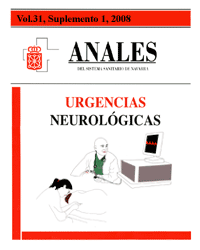Los trastornos del movimiento en urgencias
Palabras clave:
Síndrome neuroléptico maligno, Síndrome serotoninérgico, Urgencias en la enfermedad de Parkinson, Distonía secundaria a fármacosResumen
Los pacientes que acuden a urgencias con un cuadro clínico en el que predomina un trastorno del movimiento de instauración aguda o subaguda suponen un porcentaje pequeño de las urgencias neurológicas. Sin embargo, su conocimiento es importante ya que en muchos de estos casos un error en el diagnóstico o tratamiento puede conllevar una importante morbilidad e incluso mortalidad. La forma clínica de presentación de estos trastornos es variada y en algunos predomina la acinesia o la rigidez mientras que en otros casos son los movimientos anormales en forma de discinesias o balismos lo que caracterizan al cuadro clínico. El tipo de trastorno del movimiento orienta hacia una determinada etiología. El consumo de determinados fármacos o tóxicos supone una de las principales causas de trastorno agudo del movimiento dentro de las que se incluyen el síndrome neuroléptico maligno y el síndrome serotoninérgico. En esta revisión se ha dedicado un apartado a las urgencias que plantea la enfermedad de Parkinson y que incluyen el síndrome parkinsonismo-hiperpirexia, la psicosis aguda y las urgencias de los pacientes con neuroestimuladores. Las distonías y corea-balismo agudas son también abordadas, y por último se dedica un apartado a las trastornos del movimiento como forma de presentación de un ictus.Descargas
Descargas
Publicado
Cómo citar
Número
Sección
Licencia
La revista Anales del Sistema Sanitario de Navarra es publicada por el Departamento de Salud del Gobierno de Navarra (España), quien conserva los derechos patrimoniales (copyright ) sobre el artículo publicado y favorece y permite la difusión del mismo bajo licencia Creative Commons Reconocimiento-CompartirIgual 4.0 Internacional (CC BY-SA 4.0). Esta licencia permite copiar, usar, difundir, transmitir y exponer públicamente el artículo, siempre que siempre que se cite la autoría y la publicación inicial en Anales del Sistema Sanitario de Navarra, y se distinga la existencia de esta licencia de uso.








